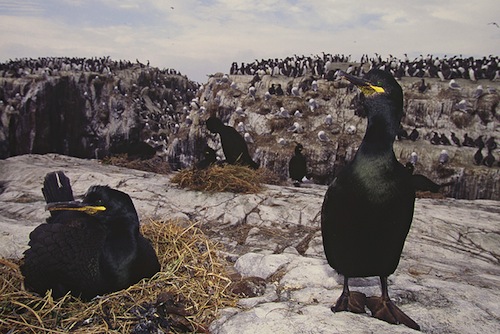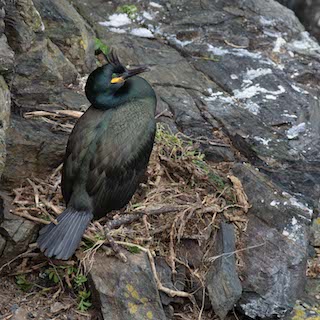 This Shag was spotted building its nest at Lizard Point.
This Shag was spotted building its nest at Lizard Point.
Photo: © Richard Birchett
Scientific name: Phalacrocorax aristotelis
Other common names: European Shag, Common Shag, Green Cormorant
Cornish name: Drenen gough
Conservation status: UK Birds of Conservation Concern, Amber; IUCN Red List, Least Concern
What to look for:
- Colouring and appearance: A similar size to a goose, in the breeding season the adult Shag develops dark green glossy plumage, a purple tinge to its wings, a yellow patch at the base of its black bill, and a black crest on the forecrown (which is up-curved in the early breeding season). Immature and wintering birds are duller. Shags have long slim necks, and thin dark coloured bills which are paler in wintering and immature birds.
- Size: Length 68 to 78 cm, wingspan 95 to 110 cm.
- Where: On coastal sites, mainly in the north and west of Britain, in the breeding season; wintering birds are found round the coast of Wales and south-western England. Global distribution is Europe, southwest Asia and northern Africa.
- Call: Grunting and clicking.
- Similar species: Cormorant. Shags are smaller and usually slimmer than Cormorants, with a thinner neck and bill. In flight, the Shag has a straighter neck and blunter wings, and tends to fly closer to the water surface.
 The European Shag’s habit of diving beneath the sea surface for several seconds and then bobbing back in a slightly different location before diving again makes it (and its close cousin, the Cormorant) very familiar round our coastline. Shags tend to jump higher from the water before diving than do Cormorants, therefore making slightly more splash, but it can be hard for a non-birder to tell them apart from a distance.
The European Shag’s habit of diving beneath the sea surface for several seconds and then bobbing back in a slightly different location before diving again makes it (and its close cousin, the Cormorant) very familiar round our coastline. Shags tend to jump higher from the water before diving than do Cormorants, therefore making slightly more splash, but it can be hard for a non-birder to tell them apart from a distance.
They are, of course, diving for food. They are opportunistic feeders, eating many species of small fish, but have a particular preference for sand eels, diving to great depths using their wide webbed feet to take their prey from the sea floor. Birds will travel a few kilometres to find food, but rarely go out of sight of land.
Their main British breeding grounds are further north: they include the Farne Islands in England, and sites in the northwest and islands of Scotland: here, they are of the subspecies P. aristotelis aristotelis, which has Amber conservation status in the UK because of recent declines in numbers, and the need to protect the low number of breeding sites. There are smaller breeding populations elsewhere, including the coastline of Devon and Cornwall. The Shag is not a migratory species: most Shags stay within 100 km of their breeding ground (juveniles sometimes disperse further, up to 200 km). Some of the northern Europe populations do however move further south in winter, and some birds overwinter on the east coast of Britain.
 The global breeding range covers the rocky coastline of north and west Europe and Asia, and northern Africa. The birds make untidy stick and seaweed nests, glued together using their own guano, in colonies on ledges and crevices; the rotting seaweed imparts a strong smell to the nest. Females lay up to three eggs. After hatching, the young birds are dependent on their parents for up to two months before fledging. They reach breeding maturity at four years; the oldest bird ringed was almost 30 years old.
The global breeding range covers the rocky coastline of north and west Europe and Asia, and northern Africa. The birds make untidy stick and seaweed nests, glued together using their own guano, in colonies on ledges and crevices; the rotting seaweed imparts a strong smell to the nest. Females lay up to three eggs. After hatching, the young birds are dependent on their parents for up to two months before fledging. They reach breeding maturity at four years; the oldest bird ringed was almost 30 years old.
Did you know…?
…The European Shag is one of the deepest-diving members of the cormorant family, reaching depths of up to 45 m.
…The common name Shag is from the Old Norse for beard, referring to the summer breeding crest. The genus name Phalacrocorax is from the Greek for ‘bald raven’, and the species name aristotelis is in honour of the Greek natural philosopher Aristotle.
More information and references:
Svensson, L., Mullarney, K., Zetterstrom, D.,1986. Collins Bird Guide, second edition (translated by Christie, D., Svensson, L.). HarperCollins, London.
Published: November 2014 (updated March 2020)
Author: Amanda Scott
Photos: Upper, © Natural England/Paul Glendell; lower, of bird on nest, showing its breeding crest © Richard Birchett
